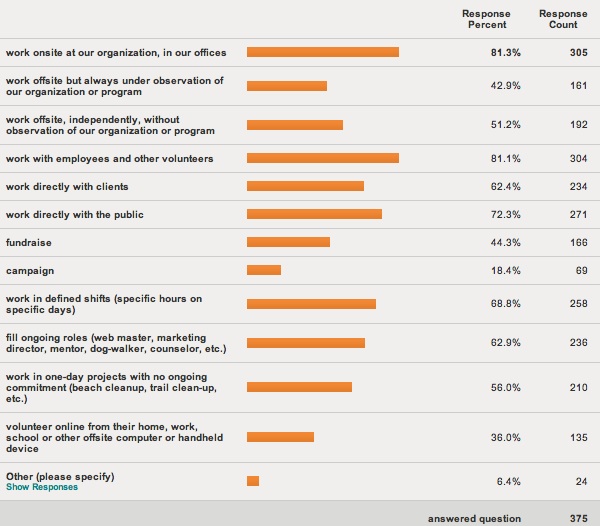 Last week, Rob Jackson and I published the results of a survey (in PDF) regarding software used by nonprofits, NGOs, charities, schools, government agencies and others to manage volunteer information. The purpose of the survey was to gather some basic data that might help organizations that involve volunteers to make better-informed decisions when choosing software, and to help software designers to understand the needs of those organizations.
Last week, Rob Jackson and I published the results of a survey (in PDF) regarding software used by nonprofits, NGOs, charities, schools, government agencies and others to manage volunteer information. The purpose of the survey was to gather some basic data that might help organizations that involve volunteers to make better-informed decisions when choosing software, and to help software designers to understand the needs of those organizations.
But we learned some things that had nothing to do with software.
We asked a lot of questions that didn’t related directly to software, like about how many volunteers these organizations managed, as well as what volunteers did.
We expected the percentage of volunteers that worked onsite to be huge. We were very surprised, and pleased, to find, instead, that so many organizations that responded to our survey involved volunteers that:
- worked offsite, with no direct supervision by staff
- worked directly with clients
- worked directly with the general public
- worked online from their home, work, school or other offsite computer or handheld device
(virtual volunteering, including microvolunteering) - engaged in on-off activities, like a beach cleanup – otherwise known as episodic volunteering
You can see the breakdown for yourself here:

We believe this diversity of responses is enough to bust the long-held stereotype that most volunteers work only onsite, directly under staff supervision, or that the vast majority of volunteers undertake long-term responsibilities, and that episodic volunteering or microvolunteering is a radical new, untested concept.
May we say goodbye to those stereotypes at long last? There’s no one way to involve volunteers – there never has been! Let’s recognize the reality of the diversity of ways volunteers are supporting organizations!

Hi Jayne. I really enjoyed your findings on this topic. I am doing a research project for my Nonprofit Management class on recruitment and retainment of volunteers of all ages and think this article brings up a great point about the variety and frequency of options available to volunteers. With your evidence on the variety of types of volunteer involvement, how do you think this affects, or doesn’t affect, the ability of organizations to recruit (and retain) volunteers? Thanks for your post.
I think this affects organizations very negatively if they are locked into the thinking that volunteers can be involved only one way. I’m always shocked when I encounter that kind of thinking – someone who can only think of a volunteer as a person who can come in on the same days and times every week, and commit indefinitely to that role. I wish I could say this shock comes rarely, but it actually comes *regularly*, particularly when I’m working with formal associations of volunteer managers. Sadly, there are also funders – corporations, foundations and the like – that also can get locked into this way of thinking. We weren’t at all expecting to find that *most* of the organizations we surveyed involved volunteers in such a variety of ways – this was a survey regarding volunteer management software, not volunteer involvement, specifically – but we were so thrilled with this finding, as it shows that "old-fashioned" thinking is dying out, and that’s great news for organizations and volunteers alike!